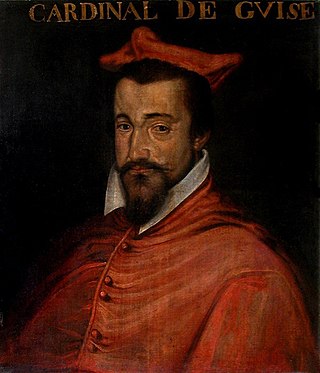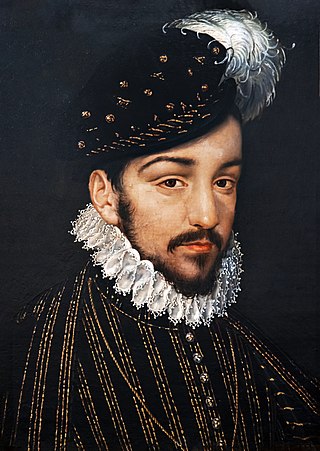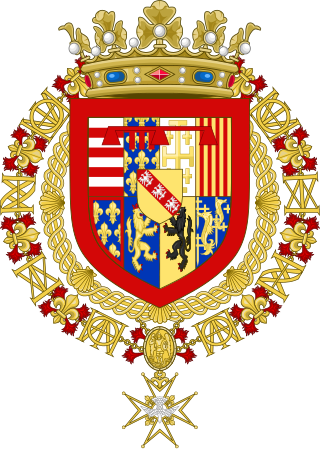
Catherine de' Medici was a Florentine noblewoman born into the Medici family. She was Queen of France from 1547 to 1559 by marriage to King Henry II and the mother of French kings Francis II, Charles IX, and Henry III. The years during which her sons reigned have been called "the age of Catherine de' Medici" since she had extensive, if at times varying, influence in the political life of France.

Henry IV, also known by the epithets Good King Henry or Henry the Great, was King of Navarre from 1572 and King of France from 1589 to 1610. He was the first monarch of France from the House of Bourbon, a cadet branch of the Capetian dynasty. He pragmatically balanced the interests of the Catholic and Protestant parties in France as well as among the European states. He was assassinated in 1610 by a Catholic zealot, and was succeeded by his son Louis XIII.

The French Wars of Religion refers to the period of civil war between French Catholics and Protestants from 1562 to 1598. Between two and four million people died from violence, famine or disease directly caused by the conflict, and it severely damaged the power of the French monarchy. One of its most notorious episodes was the St. Bartholomew's Day massacre in 1572. The fighting ended with a compromise in 1598, when Henry of Navarre, who had converted to Catholicism in 1593, was proclaimed King Henry IV of France and issued the Edict of Nantes, which granted substantial rights and freedoms to the Huguenots. However, Catholics continued to disapprove of Protestants and of Henry, and his assassination in 1610 triggered a fresh round of Huguenot rebellions in the 1620s.

Charles de Lorraine, duc de Mayenne was a French noble, governor, military commander and rebel during the latter French Wars of Religion. Born in 1554, the second son of François de Lorraine, duke of Guise and Anne d'Este, Mayenne inherited his fathers' position of Grand Chambellan in 1563 upon his death. He fought at the siege of Poitiers for the crown in 1569, and crusaded against the Ottomans in 1572. He served under the command of the king's brother Anjou during the siege of La Rochelle in the fourth war of religion, during which he was wounded. While the siege progressed, his uncle was killed by a cannonball, and he inherited his position as governor of Bourgogne. That same year, his marquisate of Mayenne was elevated to a duché pairie. He travelled with Anjou when he was elected as king of the Commonwealth and was a member of his court there until early 1574 when he departed on crusade again. Returning to France, he served in the fifth war of religion for Anjou, now king Henri III of France, but his badly underfunded army was unable to seriously impede the Protestant mercenary force under Casimir. He aligned himself with the Catholic Ligue that rose up in opposition to the generous Peace of Monsieur and fought in the sixth war of religion that resulted, serving at the sieges of La Charité-sur-Loire and Issoire. During 1576, he married Henriette de Savoie-Villars, securing a sizable inheritance in the south west, and the title of Admiral on the death of her father in 1578. Mayenne was granted full command of a royal army during the seventh war of religion in 1580, besieging the Protestant stronghold of La Mure successfully, and clearing several holdout towns after the peace. In 1582 he was obliged to surrender his title of Admiral to Joyeuse, a favourite of Henri. The following year he was involved in an abortive plan to invade England, though it came to nothing due to lack of funds.

Henry I, Prince of Joinville, Duke of Guise, Count of Eu, sometimes called Le Balafré ('Scarface'), was the eldest son of Francis, Duke of Guise, and Anna d'Este. His maternal grandparents were Ercole II d'Este, Duke of Ferrara, and Renée of France. Through his maternal grandfather, he was a descendant of Lucrezia Borgia and Pope Alexander VI.
The War of the Three Henrys, also known as the Eighth War of Religion, took place during 1585–1589, and was the eighth conflict in the series of civil wars in France known as the French Wars of Religion. It was a three-way war fought between:

The Edict of Saint-Germain, also known as the Edict of January, was a landmark decree of tolerance promulgated by the regent of France, Catherine de' Medici, in January 1562. The edict provided limited tolerance to the Protestant Huguenots in the Catholic realm, though with counterweighing restrictions on their behaviour. The act represented the culmination of several years of slowly liberalising edicts which had begun with the 1560 Edict of Amboise. After two months the Paris Parlement would be compelled to register it by the rapidly deteriorating situation in the capital. The practical impact of the edict would be highly limited by the subsequent outbreak of the first French Wars of Religion but it would form the foundation for subsequent toleration edicts as the Edict of Nantes of 1598.

Jacques de Savoie, duc de Nemours was a French military commander, governor and Prince Étranger. Having inherited his titles at a young age, Nemours fought for king Henri II during the latter Italian Wars, seeing action at the siege of Metz and the stunning victories of Renty and Calais in 1554 and 1558. Already a commander of French infantry, he received promotion to commander of the light cavalry after the capture of Calais in 1558. A year prior he had accompanied François, Duke of Guise on his entry into Italy, as much for the purpose of campaigning as to escape the king's cousin Antoine of Navarre who was threatening to kill him for his extra-marital pursuit of Navarre's cousin.

Charles de Lorraine, duc d'Aumale was a French noble, military commander and governor during the latter French Wars of Religion. The son of Claude, Duke of Aumale and Louise de Brézé, Aumale inherited his families position in north eastern France, and his fathers title of Grand Veneur. Educated as a fervent Catholic, his clients engineered the creation of the first national Catholic Ligue in 1576, and he continued to support the remnants of the organisation after the Treaty of Bergerac caused much of the ligue to dissolve. During the sixth civil war that the ligue had induced, he fought with the king's brother Alençon at the sieges of La Charité-sur-Loire and Issoire. During the seventh civil war in 1579, he brought his ligueur forces to support the royal army under Marshal Matignon during the siege of La Fère but left on bitter terms with the commander when the siege was brought to a close on generous terms.

Louis II de Lorraine, cardinal de Guise was a French prelate, Cardinal and politician during the latter French Wars of Religion. The third son of François de Lorraine, duke of Guise and Anne d'Este Louis was destined for a career in the church. His uncle Cardinal Lorraine resigned his offices of Archbishop of Reims to him in 1574, and the death of his other uncle Louis I de Lorraine, Cardinal de Guise passed his ecclesiastical empire on to him upon his death in 1578. At which time the king made him Cardinal. Cardinal Guise actively involved himself in the first Catholic Ligue that rose up in opposition to the generous Peace of Monsieur which brought the fifth war of a religion to a close in 1576. The ligue succeeded in resuming the civil war the next year and a harsher peace was concluded. Over the following years of peace he would feud with Épernon, and receive Henri III's new honour when he was made a chevalier de l'Ordre du Saint-Esprit in 1578 among the first cohort. Finally reaching the ecclesiastical age at which he could assume his responsibilities as Archbishop of Reims in 1583 he entered the city in triumph and oversaw a council at which he pushed for the promulgation of the Tridentine Decrees.

Gaspard de Saulx, sieur de Tavannes was a French Roman Catholic military leader during the Italian Wars and the French Wars of Religion. He served under four kings during his career, participating in the Siege of Calais (1558) and leading the royal army to victory in the third civil war at the Jarnac and Moncontour. A strong Catholic, he founded the confraternity of the holy ghost in 1567 which would be a template for other militant Catholic organisations across France. He died in 1573, shortly after the opening assassinations of the Massacre of Saint Bartholomew, which he had helped plan.

The Peace of Longjumeau was signed on 23 March 1568 by Charles IX of France and Catherine de' Medici. The edict brought to an end the brief second French Wars of Religion with terms that largely confirmed those of the prior edict of Amboise. Unlike the previous edict it would not be sent to the Parlements to examine prior to its publication, due to what the crown had felt was obstructionism the last time. The edict would not however last, and it would be overturned later in the year, being replaced by the Edict of Saint-Maur which outlawed Protestantism at the beginning of the third war of religion.

Charles de Bourbon, Cardinal de Bourbon, Archbishop of Rouen was a French noble, prelate and disputed King of France as the Catholic Ligue candidate from 2 August 1589 – 9 May 1590. Born the third son of Charles of Bourbon, Duke of Vendôme and Françoise d'Alençon he was destined for a career in the church. As a member of the House of Bourbon-Vendôme he was one of the premier Prince du sang. Already having secured several sees, he was made a Cardinal by Pope Paul III in January 1548. In 1550 he received the office of Archbishop of Rouen making him the Primate of Normandy. The following year the promotion of Bourbon to Patriarch of the French church was threatened by King Henry II to secure concessions from the Pope. During the Italian Wars which resumed that year he played a role supporting Catherine de Medici's regency governments in France and briefly holding a lieutenant-generalship in Picardy. In 1557 the Pope appointed the Cardinals Bourbon, Lorraine and Châtillon as the leaders of an inquisition in France to root out heresy. The effectiveness of their inquisition would be obstructed by both the king and the Parlements and by July 1558 their appointments were voided by the Parlement of Paris.

Catherine of Cleves, Countess of Eu was the wife of Henry I, Duke of Guise and the matriarch of the powerful and influential House of Guise. By marriage, she was Duchess of Guise from 1570 to 1588, and Dowager Duchess of Guise thereafter. She was also Countess of Eu in her own right from 1564.

Henry IV of France's succession to the throne in 1589 was followed by a four-year war of succession to establish his legitimacy, which was part of the French Wars of Religion (1562–1598). Henry IV inherited the throne after the assassination of Henry III, the last Valois king, who died without children. Henry was already King of Navarre, as the successor of his mother, Jeanne d'Albret, but he owed his succession to the throne of France to the line of his father, Antoine of Bourbon, an agnatic descendant of Louis IX. He was the first French king from the House of Bourbon.

Charles I de Lorraine, duc d'Elbeuf was a French noble, military commander and governor during the French Wars of Religion. The son of the most minor cadet house of the children of Claude, Duke of Guise, Elbeuf initially lacked the prominence of his cousins, however his succession to the Rieux inheritance made him important. Over the following decades he would gradually consolidate more of it under his authority, until by his death in 1605, all of the county of Harcourt belonged to the Elbeufs. A young man in 1573, he travelled with the king's brother to assume his kingship of the Commonwealth. Upon the prince's return as Henri III of France in 1574 Elbeuf would receive the honour of assuming the position of grand chamberlain during the coronation. After the establishment of the Ordre du Saint-Esprit in 1579, Elbeuf would be elevated as a knight of this chivalric body. The following year he supported the king's brother Alençon in his negotiations with the Dutch States General to assume the role of king. In the wake of these successful, if fraught, negotiations, he was nominated by Alençon as lieutenant-general of his army. Elbeuf and Alençon would travel to the Spanish Netherlands where they would relieve the besieged town of Cambrai, to much acclaim from the citizenry. Shortly after this, relations soured between Elbeuf and the prince, and Elbeuf retired back to his estates with the excuse of an illness, being refused when he offered to return the following year. In September 1581, his marquisate of Elbeuf was elevated to a peerage duchy, greatly elevating Elbeuf's social standing.

Catherine-Marie de Lorraine, Duchess of Montpensier, was a French princess from the house of Guise who played a leading political role in the Catholic League during the French Wars of Religion.

The Edict of July, also known as the Edict of Saint-Germain was a decree of limited tolerance promulgated by the regent of France, Catherine de' Medici, in July 1561. Whilst it emphasised a continued commitment to banning Huguenot worship in France, it granted pardon for all religious offenses since the reign of Henry II, who had died two years earlier, which was a victory for the Protestant community. A further Protestant victory was in the reaffirmation of the removal of the death penalty for heresy cases. The edict would be overtaken by events, and ultimately left unenforced as France moved first to the landmark Edict of Saint-Germain and then into the Wars of Religion.

Jacques II de Goyon seigneur de Matignon (1525-1598) was a governor and Marshal of France. Coming from a prominent Norman family, he assumed the role of Lieutenant-General of lower Normandy. In this position he came into conflict with the Protestant governor of Normandy Bouillon. During the first civil war Matignon would come into conflict with the governor, who occupied a third individual position between the crown and the rebels as he felt his authority eroded. In 1574 the governorship of Normandy which had become vacant was split into three separate offices between Matignon, Meilleraye and Carrouges. He would hold the governorship until it was reunited in 1583 for Henri III's favourite Anne de Joyeuse

Gaspard de Schomberg, comte de Nanteuil was a French soldier, courtier, diplomat, statesman and governor during the French Wars of Religion. Of Sachsen descent, Gaspard naturalised as French. He began his career during the first French War of Religion, when he fought with the Protestants against the crown, raising mercenaries in the Holy Roman Empire for the prince of Condé. The crown was impressed with his abilities, and co-opted his services, during the third civil war he would fight against the Protestants. In 1570 he was made a gentilhomme de la chambre du roi, and then a Chambellan and in these years he would conduct a series of diplomatic missions to further French foreign policy with the princes of the empire. In 1573 he helped prepare the way for Anjou, travel to his new kingdom, the Polish-Lithuanian Commonwealth. When Anjou returned to France as Henri III Schomberg supported him in the civil war he inherited, reporting on the mercenary situation in the empire, and fighting at the Battle of Dormans. His wealth during this period allowed him to take advantage of the Duke of Guise's financial woes, securing for himself the county of Nanteuil-le-Haudoin in 1578 for several hundred thousand livres.

















